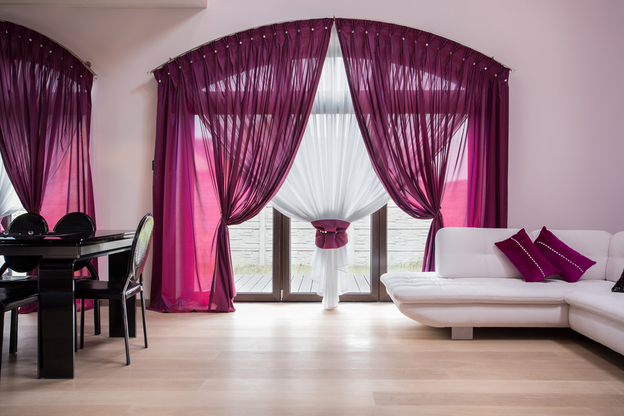Unravel the intricate details of selecting the ideal drape panel width as this comprehensive guide dives into the significance of width in drapery design, various styles, fabric types, and practical tips for measuring and customization to elevate the aesthetics and functionality of your event or interior space.
Jump Links
- Introduction: The Importance of Drape Width
- Determining the Appropriate Drape Width
- Drape Width Guidelines
- Styles that Affect Drape Width
- Fabric Types and Their Impact on Drape Width
- Measuring for Accurate Drape Width
- Tips for Customizing Store-Bought Drapes
- Proper Care and Maintenance for Drapes
- In Conclusion: Finding the Perfect Drape Width for Your Space
- Drape Panels FAQs
Introduction: The Importance of Drape Width
Determining the correct width for your drape panels is critical to achieving a visually appealing and functionally effective window treatment. This aspect of drapes, often overlooked, can significantly impact the aesthetics and functionality of your space. If the panels are narrow enough, they may adequately cover the window and look more robust. Conversely, too wide panels may appear overwhelming or create an unattractive bunching effect. This guide will help you navigate the ins and outs of determining the perfect drape panel width.
In events and interior design, drapes are an integral component, and selecting the appropriate width is as critical as choosing the suitable fabric or style. The correct drape width adds finesse and a sense of balance to the room. Whether creating an enchanting backdrop for a wedding, setting up an exhibit booth, or designing a corporate space, drapes play a pivotal role in setting the ambiance.
As North America’s market leader in event rentals, Quest Events recognizes the significance of impeccable drape selection. We provide many options in drape panels, ensuring quality and versatility. Our experience serving diverse industries, including AV, hospitality, corporate, wedding, and exhibition sectors, has endowed us with the expertise to comprehend the subtleties and nuances of drape selection.
Moreover, with our extensive footprint across the United States and service capabilities in Canada, we pride ourselves on offering our clients the most creative, efficient, and comprehensive rental solutions and installation services. We understand that details matter, and ensuring the correct drape width is one of those details that can make or break the overall look and functionality of a space.
This guide delves into the various factors and considerations in determining drape width. From understanding the role of drapes in interior design to practical measurement techniques, we have got you covered. This guide is designed to serve as a resource for industry professionals, event planners, and individuals seeking to create visually beautiful spaces using drapes.
The Role of Drapes in Interior Design
Drapes are not just functional elements that provide privacy and control the influx of light; they are a fundamental part of a room’s interior design. They can set the tone for a room, add color, pattern, and texture, or introduce an elegant, casual, or formal style. The width of the drape can significantly influence these aspects, contributing to the overall look and feel of your room.
Factors to Consider When Choosing Drape Width
Several factors play into selecting the perfect drape width. The size and shape of your window, the desired level of light control and privacy, the style of drapes, and the fabric used all influence the optimal width for your drape panels.
Determining the Appropriate Drape Width
The Window’s Dimensions
As a starting point, measure your window’s dimensions. This measurement will not only determine the width of your drape panels but also influence the length and overall look of your drapes. A common rule of thumb is to make the drapes at least twice the window width for a rich, complete look.
The Desired Look and Functionality
Fullness and Gather
Fullness refers to the amount of fabric used in the drapes, impacting how they hang and gather. For a more formal or luxurious look, consider a higher fullness ratio, such as 2:1 or even 3:1. For a casual or minimalist aesthetic, a lower fullness ratio, such as 1:1, might be more suitable.
Light Control and Privacy
If light control and privacy are priorities, a broader panel that can fully cover the window even when gathered is recommended. Dark-colored or blackout drapes are excellent for these purposes. However, the width is still vital to achieving the desired effect.
Drape Width Guidelines
Standard Fullness Ratios
The industry-standard fullness ratio is 2:1, meaning the total width of the drape panels is two times the window’s width. However, this ratio can be adjusted based on your preferences for style and function. For a luxurious, gathered look, a ratio of 3:1 can be used. Conversely, a ratio of 1:1 or 1.5:1 might be more suitable for a sleek, modern appearance.
Additional Considerations for Unique Window Treatments
Not all windows are standard sizes or shapes. Additional considerations are required for bay windows, corner windows, or other unique treatments. Consult a professional to determine the most effective drape width for these cases.
Styles that Affect Drape Width
Grommet and Tab Top Drapes
Grommet and tab top drapes, known for their casual, laid-back style, usually require more comprehensive panels due to their design. The fabric is evenly distributed along the rod, requiring more material for a pleasing appearance.
Pleated Drapes
Pleated drapes, such as pinch pleat or box pleat styles, are more traditional and formal. They create a tailored look with less fabric, so that you might opt for a slightly narrower panel width than grommet or tab top drapes.
Rod Pocket Drapes
Rod pocket drapes have a relaxed feel and are an excellent choice for casual settings. They can accommodate various widths, but it is crucial to ensure the panel is wide enough to avoid looking too sparse when gathered on the rod.
Fabric Types and Their Impact on Drape Width
Lightweight Fabrics
Lightweight fabrics like cotton, linen, or sheer materials flow and drape well. They require more width to achieve a complete and luxurious look. When using lightweight fabrics, consider the transparency and how it affects privacy and light control.
Heavyweight Fabrics
Heavyweight fabrics like velvet, brocade, or heavy cotton have a more structured drape. They can create a rich, opulent feel even without using much material. However, it’s essential to ensure that they look light enough. A standard fullness ratio of 2:1 is often sufficient for heavyweight fabrics.
Mixing Fabric Weights for a Balanced Look
Combining lightweight and heavyweight fabrics can create a balanced and dynamic appearance. For instance, a sheer, lightweight fabric behind a heavier drape can add depth and contrast while allowing for variable light control.
Measuring for Accurate Drape Width
Tools and Techniques for Proper Measurement
You’ll need a metal tape measure for accuracy, a ladder, and an assistant for larger windows to measure for drape width. Measure the window’s width from the outer edges of the window molding and not just the glass. For drapes mounted outside the window frame, measure the length of the curtain rod instead. Adding 4-6 inches on both sides for overlap and 2-3 inches for clearance from the window molding is advisable.
Accounting for Mounting Hardware
Consider the mounting hardware when measuring for drape width. Rods and brackets can add several inches to the total width. Remember that drapes should extend slightly beyond the rod’s length to ensure adequate coverage and prevent light leakage on the sides.
Tips for Customizing Store-Bought Drapes
Altering Drape Width
Not all store-bought drapes will be the perfect width for your windows. In some cases, alterations may be necessary. Most drapes can be altered by a professional tailor or even as a DIY project if you have sewing skills.
Combining Drapes for Wider Coverage
In cases where a single drape panel is not wide enough, you can use two or more panels to achieve the desired width. Ensure that the drapes are hung in a way that creates a seamless appearance.
Proper Care and Maintenance for Drapes
Cleaning Techniques for Different Fabric Types
The cleaning techniques for drapes vary depending on the fabric type. While some fabrics are machine washable, others may require dry cleaning. Always check the manufacturer’s instructions before cleaning your drapes.
Periodic Adjustments to Keep Drapes Looking Fresh
Over time, drapes may stretch or sag. Periodically check for any needed adjustments. Don’t hesitate to re-hem or take in the sides to keep them looking their best.
In Conclusion: Finding the Perfect Drape Width for Your Space
Finding the perfect drape width is an essential aspect of room design that requires careful consideration and planning. Not only does it influence the aesthetic appeal of your room, but it also plays a significant role in the functionality of your window treatments.
First, start by analyzing the space and the window you are working with. Understanding the window’s dimensions is fundamental. Next, think about the purpose that the drapes will serve. Are they primarily decorative, or must they provide privacy and light control? This will guide you in selecting the appropriate fabric types.
It’s also important to reflect on the style of the room. Whether modern, classic, casual, or formal, the drape style should complement the room’s decor. Different styles like grommet, pleated, or rod pocket drapes each come with their considerations for width.
Remember, the fullness of drapes is crucial in achieving the desired look. Fullness refers to the ratio of the drape’s width to the window’s width. A standard fullness ratio is 2:1, which can be adjusted according to your preferences. Luxurious settings may benefit from a higher fullness ratio, while sleek, modern designs look better with less fullness.
Fabric choice is another decisive factor. Lightweight fabrics may require more width to look ample and elegant. In contrast, heavyweight fabrics can achieve a rich look without as much material. Sometimes, mixing fabric weights can create an exciting and layered effect.
Measuring accurately for your drape width is imperative. Consider the window dimensions and the additional width needed for mounting hardware and desired overlaps. Consider seeking professional help if you are unsure, especially for unique window shapes.
If you’re working with store-bought drapes, know customization is always an option. Alterations can be made to ensure that the drapes fit perfectly. Combining drapes is also an option if broader coverage is needed.
Lastly, proper care and maintenance are crucial to keep your drapes looking pristine. Follow the manufacturer’s cleaning guidelines and make adjustments as needed.
In conclusion, selecting the ideal drape width involves a blend of accurate measurement, style consideration, and functionality. With the insights and guidelines presented in this guide, Quest Events empowers you to make well-informed decisions in choosing the right drape panels that will not only enhance the beauty but also increase the efficacy of your space. As North America’s market leader in event rentals, we are committed to providing creative, effective, and efficient rental solutions and installation services. Do not hesitate to contact our experts for personalized advice and assistance.
Drape Panels FAQs
The standard width for drape panels is typically twice the window’s width. However, this can vary depending on the fabric type and desired fullness.
How do I measure my window for drapes?
Measure the width from the outside edges of the window molding. If the drapes are mounted outside the window frame, measure the length of the curtain rod and add 4-6 inches for overlap.
Can I mix different fabric weights in window treatments?
Yes, mixing different fabric weights can create depth and contrast. For example, a sheer, lightweight fabric behind a heavier drape can add dimension and allow for variable light control.
How do I clean and maintain my drapes?
Always follow the manufacturer’s cleaning instructions. Some fabrics are machine washable, while others require dry cleaning. Periodically check for adjustments like re-hemming or taking in the sides to keep drapes looking fresh.
What if my windows are not of standard dimensions?
For windows with non-standard dimensions, opting for custom-made drapes is best. Take precise window measurements and consult a professional to have drapes tailored to the specific dimensions and desired style. Custom drapes allow for greater flexibility and precision in achieving the perfect fit and look.


